Ríoverde, San Luis Potosí 作者: 来源: 发布时间:2021-11-18
1.Population and Area
Pop: 49,183 (city)
Area: 3,109.71 km2 (munip.)
Elev: 1006 masl
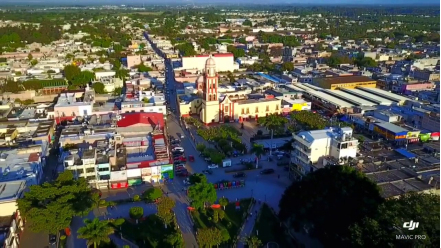
2. Natural geography
Nature and weather
Flora and fauna
The vegetation is predominant in microphilous desert scrub such as: governor, mesquite, huizache, hojasén and granjeno. To the south there are patches of forest of various varieties.
The fauna is characterized by the dominant species such as: coyote, white-tailed deer, wild boar, badger, opossum, rattlesnake, hare and young lion.
The municipality has "El Potosí", as a protected natural area, with a decree of the year 1936, as a national park with an area of 2,000 ha. including the municipality of Santa María del Río. Likewise, there is the protected natural area in the Plama Larga state park modality, according to the decree of June 5, 1998.
Köppen Classification: Oceanic Subtropical Highland Climate
This climate type is characterized by extremely variable temperature conditions, with annual means decreasing and annual ranges increasing poleward, and relatively little precipitation. This climate is typically located deep within the interiors of continents and is contiguous with the tropical desert climates of North and South America and of central Asia. This region type owes its origins to locations deep within continental interiors, far from the windward coasts and sources of moist, maritime air. Remoteness from sources of water vapor is enhanced in some regions by mountain barriers upwind.
The Köppen Climate Classification subtype for this climate is "Bsh". (Mid-Latitude Steppe and Desert Climate).
The average temperature for the year in Rioverde is 64.6°F (18.1°C). The warmest month, on average, is May with an average temperature of 71.2°F (21.8°C). The coolest month on average is January, with an average temperature of 56.5°F (13.6°C).
The highest recorded temperature in Rioverde is 104.0°F (40°C), which was recorded in May. The lowest recorded temperature in Rioverde is 21.2°F (-6°C), which was recorded in December.
The average amount of precipitation for the year in Rioverde is 10.5" (266.7 mm). The month with the most precipitation on average is July with 2.2" (55.9 mm) of precipitation. The month with the least precipitation on average is December with an average of 0.1" (2.5 mm). In terms of liquid precipitation, there are an average of 37.3 days of rain, with the most rain occurring in September with 6.5 days of rain, and the least rain occurring in March with 1.0 days of rain.
http://www.weatherbase.com/weather/weather-summary.php3?s=924062&cityname=Rioverde%2C+San+Luis+Potosi%2C+Mexico&units=
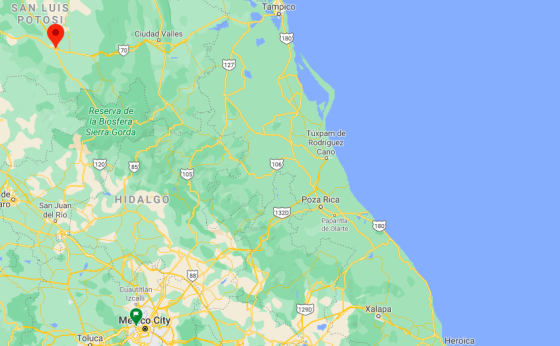
Getting there and around
Get there
By plane – The quickest way to get from Mexico City to Rioverde is to fly and bus which costs $1500 - $6000 and takes 5h 17m. The quickest flight from Mexico City Airport to San Luis Potosi Airport is the direct flight which takes 1h 5m.
By car – The distance between Mexico City and Rioverde is 293 km. The road distance is 505.9 km. It takes approximately 6h to drive from Mexico City to Rioverde.
By bus – The cheapest way to get from Mexico City to Rioverde is to bus via Xilitla which costs $774 - $776 and takes 15h 12m. There are services departing from Izazaga and arriving at Rioverde via México Central Norte and Xilitla. The journey, including transfers, takes approximately 15h 12m. Also, there is a direct bus that takes 7h 33m and costs $700 - $1300.
https://www.rome2rio.com/s/Mexico-City/San-Juan-del-R%C3%ADo
Rideshare – Check out Blabla Car's carpooling service for rideshare options between Mexico City and the city you are visiting. A great option if you don't have a driver's license or want to avoid public transport.
Car Rental – To explore Mexico’s provincial towns and cities—including its beach locations and the scenery and attractions near them— consider renting a car for your visit. Having your own car will give you more flexibility than using public transport options and, in some cases, offer you access to places which are otherwise difficult to visit without the use of a car.
COVID19 – International entry into Mexico from United States
Allowed for: All visitors arriving by air. Mexico land borders are closed to non-essential travel
Restricted for: There are no current restrictions.
Get around
Local Buses – Local buses and mini-buses (combis or micros) are available locally for a fraction of the cost of a taxi around town. You need to speak Spanish to be able to ask for directions or ask the driver to tell you where to get off.
Taxis – Taxis in most of Mexico’s towns and cities are not metered, so agree your price before you get in. Taxi travel is very affordable in Mexico, in comparison to the USA, Canada and Europe, and so provides a viable means of public transportation in Mexico. Your hotel can arrange taxis for you; some post their rates on a board in the lobby; taxi hotel rates are usually higher than cabs you hail off the street. If you speak Spanish, you will have a distinct advantage and be able to negotiate a price with the driver.
Uber is expanding rapidly across Mexico and now offers services in cities across the country, including: Mexico City, Toluca, Cuernavaca, Puebla, Querétaro, León, Aguascalientes, San Luis Potosí, Guadalajara, Monterrey, Hermosillo, Tijuana, Mexicali, and Mérida. Uber has been adding Mexican cities to its network every year, check for availability when you arrive at your destination in Mexico.
Cabify and Didi are also developing and currently operate in cities including Mexico City, Toluca, Monterrey, Puebla, Querétaro and Tijuana. Check for availability in the city you are visiting.
These services offer people with smartphones a way to book a cab through a mobile app for a pre-agreed price. Fares are comparable with Sitio type cabs, and sometimes trade at a premium to this when local demand increases.
https://www.mexperience.com/transport/taxi-travel-in-mexico/#51
3. ECONOMY
GDP: 11,828 M MXN (2010, Rioverde-Ciudad Fernández metro área)
https://imco.org.mx/ciudades2010/ciudades/38_Rioverde.html
4. Industry characteristics
Rioverde is an important commercial center attended by residents of surrounding communities belonging to the region.
Agriculture: A large number of agricultural products are produced, among which are: corn, beans, tomato, serrano pepper, sorghum, mandarin, lemon and orange.
Livestock: Within the larger livestock, there is the exploitation of cattle in its forms of meat and milk production, with the largest pasteurizer in the state in this municipality. In the Rioverde plain area there is horse breeding for the production of livestock food.
Among the smaller species, the breeding of the pelibuey sheep and ostriches is exploited, exploited both for meat and by furriers and tanners, in the Pastora Delegation there are important poultry breeding warehouses. In very less quantity, and basically for local consumption, pigs, sheep, rabbit and fish farming.
Industrial The municipality lacks heavy industry but has relied heavily on the light and food industry, there are also factories dedicated to the manufacture of boots, huaraches, clothing. There is a project to create an industrial zone, which will greatly benefit the economy of the region. In 2016 the first industrial company opened, Zoopas Industrias, in the same way they are settled in the municipality Pilgrim's, Pollos Querétaro, the Santa Rita Mega greenhouse, Botanas Ric, Pasteurizadora San Juan, and other distribution companies.
Beekeeping: There is an Association of Beekeepers that produce around 60 tons of honey mainly from orange blossom and mesquite, as well as multifloral honey, which due to its characteristics is highly appreciated by the European community, especially Germany, the destination to which it is exported. 80% of production.
Mining In the municipality of Río Verde there are important deposits of fluorite, zinc and topaz.
Key project: Rio Verde Solar Park
The project consists of the preparation, construction, operation and maintenance of a photovoltaic park with a generation capacity of 99.5 MW of nominal power that would have 381 thousand 408 solar modules from the firm Jinko Solar model Eagle 1500V-72 of 360 W power, plus 32 Power Electronics Free Sun inverters.
The plan includes a substation and a 115Kv power evacuation line which would be interconnected to the Río Verde substation of the Federal Electricity Commission.
The installation area of the Río Verde Solar Park is 409.9 Ha. And the firm promoting the project is GPI Next Energy.
5. Attractions
Media Luna Spring
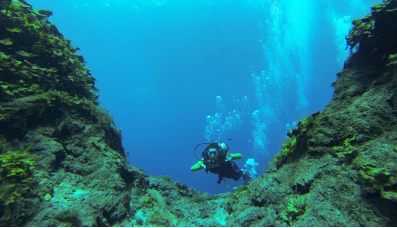
La Media Luna, in San Luis Potosí, is a spring, precisely, in the shape of a half moon that rises from the water table. The rain that falls on the Sierra Madre Oriental seeps into the subsoil and takes between 10 and 15 years to expel the water through six bubbles that are found in the depth and that feed this body of water.
In the El Jabalí ejido, Rioverde. It is part of the Potosino semi-desert.
Turtles, diving ducks and a large number of fish inhabit the Media Luna. In addition, it has a water garden of water lilies, which grow from the bottom of the spring and bloom on the surface. Its flowers and leaves are a refuge for frogs and birds.
In addition to snorkeling and free swimming, one of the main activities in Media Luna is diving. There is a school to obtain your PADI certification and be able to immerse yourself in its caves more than 30 meters deep. The training lasts four days and has a cost of 7,500 pesos.
https://www.eluniversal.com.mx/destinos/la-media-luna-esconde-un-bosque-sorprendente-bajo-la-superficie
Caverns of the Cathedral
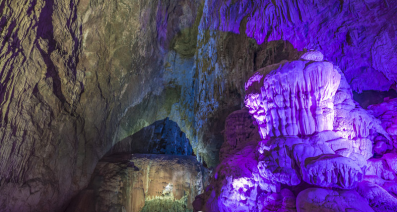
The Cathedral, Angel and Crystal Grottoes are a true gem, not only in San Luis Potosí, but throughout Mexico. They are only two and a half hours from the capital Potosina and the last stretch to get there is pure dirt, but it is totally worth it. A wonder of nature!
Very few people know about them since they were only recently discovered, but they actually formed over millions of years, giving rise to thousands of stalagmites and stalactites. These 3 caves are currently accessible, but there are probably more still undiscovered.
Las Grutas are ideal to visit any day of the year, except at Easter, which, like everywhere else, gets packed to the brim, and the problem is not the entrance, but the parking space.
https://www.sinpostal.com/grutasdelacatedral
Temple of the Divine Shepherdess
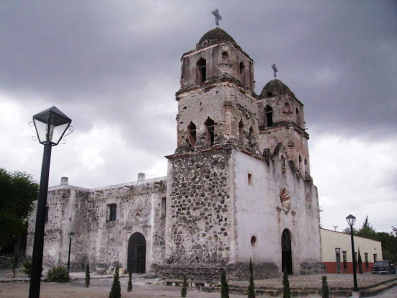
More than two centuries of history tell of the temple of La Divina Pastora, in the community of El Llano, in Rioverde. The Franciscan mission, built in 1751, stands out austere with its two towers in the middle of the valley, and inside it houses one of the few Baroque altarpieces in Catholic temples in the country, whose architectural display is one of the greatest legacies of the Viceroyalty period. .
In the 18th century, built on the border with the Greater Chichimeca, it had the objective of protecting the indigenous people who had been baptized and pacifying the nomadic groups that harassed the demarcation.
In the XXI century, inhabitants of the towns of Llano de Rioverde and Paisanos, meet in what is now the Delegation of Pastora, to commemorate the Patron Saint at her annual festival. In the temple, founded by the Franciscans, families also celebrate the arrival of migrants who return from the United States on these dates.
The religious festival, full of history, tradition, music, dance and color, brings together the community in the temple, recognized nationally, as there are only two of its kind and it is also one of the few Catholic precincts that preserve the Baroque altarpieces hand carved.
https://planoinformativo.com/394315/templo-de-la-divina-pastora-una-joya-del-siglo-xviii-en-rioverde-slp
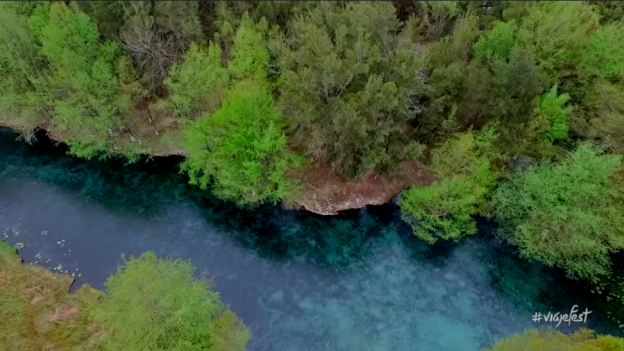
Rio Verde and The Media Luna
https://youtu.be/-Nf7OZlIsAA
6. History
Before the Spanish conquest, the region was inhabited by wild natives, they were Pames, Otomí and some groups of Chichimecas.
Founded at the beginning of the 17th century by Franciscan monks who were looking for a site for the indigenous people of Cd. Fernández, due to the legislation of that time in which the separation of races was established. First he settled in the place known as "Santa Elena", a small hill several kilometers from the Spanish town, and later moved half a kilometer to the east. The site known as "El Palmar", which was irrigated and had a well, which was where the mission was built, founded by the friar Juan Bautista de Mollinedo, in Franciscan habit, on July 1, 1617.
According to research by the Rioverde historian Eugenio Verástegui, it is believed that the name of Rioverde was given to the region by a person named Xicalchalchimitl, an Indian descendant of the kings of Texcoco, who at baptism received the name of Juan Bautista Valerio de la Cruz.
The first evangelizing friar in these lands was Fray Juan de San Miguel and later Fray Bernardo Coussin, baptizing some indigenous people in 1556 and returning years later, in 1584.
The hacienda system, the basis of the colonial economic system, was not successful in its beginnings in the Río Verde Valley, due to the hostility of the Pames Xi'oi against the Spanish who sought to take their lands and refused to be evangelized and abandon their customs and communities (such as La Manzanilla or Adjuntas) to go to live as slaves in the cities.
It was not until several decades after the Chichimeca War that the Spaniards, in need of labor, decided to bring Alaquin Indians to the valley to work for them, in addition to trying to demonstrate to the Xi'oi that "civilized" life was also possible. for the indigenous. At this time the "acequias" were built that to date feed the wells, fields and orchards that subsist in the middle of the city with fresh water from the Media Luna. Some are superficial, while others continue to run under Rioverde. they all share the same endemic animal species of the Crescent, such as silverfish and brown frogs.
During the Independence, the insurgent flag was promoted by Zenón Fernández, a native of the Villa del Dulce Nombre de Jesús (today Ciudad Fernández) being then when Rioverde began to take on greater importance than its sister city, being "La Villa" the city of the Spanish, while Rioverde was the city of the "mestizos and Indians", therefore, more populated.
On October 17, 1826, the first Political Constitution of the State of San Luis Potosí was promulgated, and in its article No. 230 it declared Rioverde the Head of one of the four Departments in which the State was divided. Subsequently, on October 5, 1827, Decree No. 60 was issued ordering that all the heads of the Department would be cities.
During the Reform War (Three Years War) Tomás Mejía (conservative) faced Mariano Escobedo (liberal) defeating him after an intense bombardment and several assaults on the church of Santa Catarina (El Palmar). After delivering the sword in the tower of the church, Escobedo prepared to be shot, receiving the pardon of Mejía, who respected him as a soldier and had esteem since the Mexican-American War.
Years later, after the fall of the Second Empire, Escobedo wanted to return piety at the Cerro de las Campanas in Querétaro, to which Mejía refused, dying by shooting together with Miguel Miramón and the Emperor Maximilian of Habsburg.
7. Contact Information
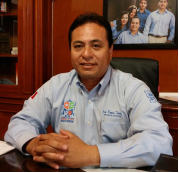
City Mayor: José Ramón Torres García
Phone number: +52 (487) 106 0302, ext. 252
Facebook: https://www.facebook.com/JoseRamonTorresGarciaOficial
Website: https://www.sanjuandelrio.gob.mx
Govt. Office Address: Constitución Letra I, Zona Centro, 79610 Rioverde, S.L.P.
